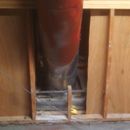How to insulate around a chimney pipe?
I have a fireplace insert in my basement. The pipe comes out of the wall, into the garage, and up to the roof. I am reinsulating this wall and I need some advise on how to insulate this. I have added a picture. I was thinking of doing some better framing around it and maybe use rigid foam insulation, but I read that building code requires a 2″ gap around. When I took the old insulation out(yellow, unfaced) it was just tucked around the pipe. What would be the best (and right) way of doing this?
GBA Detail Library
A collection of one thousand construction details organized by climate and house part










Replies
Chancey,
You should contact the manufacturer for recommendations if you have any doubts. Most chimney manufacturers include parts (kits) to allow safe wall penetrations. You are correct that most chimney manufacturers require a 2-inch air space between the chimney and any flammable material, including framing. This 2-inch gap should not be filled with insulation.
The 2" clearance between flues & combustibles are indeed enshrined in code. You are allowed to use a metal air-barrier where it passes through walls, ceilings, roof decks, but it still needs the 2" clearance that you can't fill with insulation.
Insulating with rock-wool batting in the studs/joist/rafter bays is preferable to fiberglass, and foam (particularly polystyrene foam) with just the 2" clearance would be a bit insane, even if it meets the letter of code. When going through a foam layer, use 3" or more of rock wool between the flue's 2" clearance zone and the foam.
If you're going with foam, bear in mind that polyiso and polyurethane both have an ignition temp 100F hotter than that of XPS or EPS, and unlike polystyrene, does not melt, even when fully engulfed and burning on it's own. But it's simpler & safer to just use rock wool for that section.